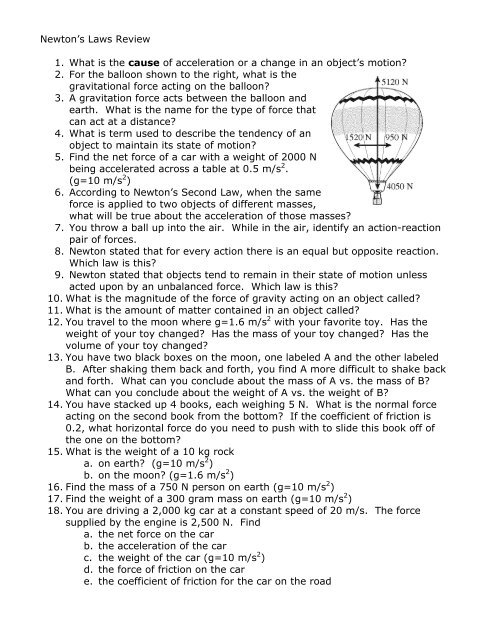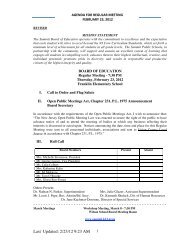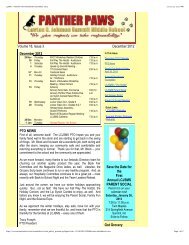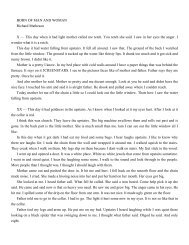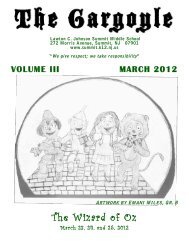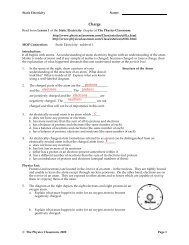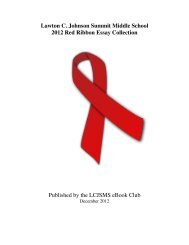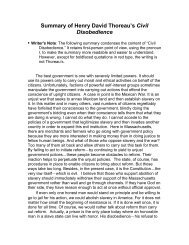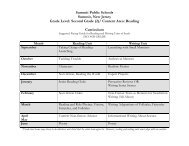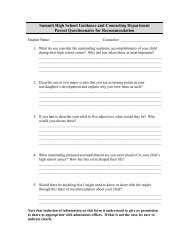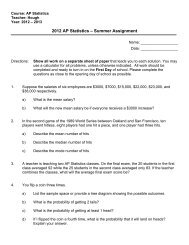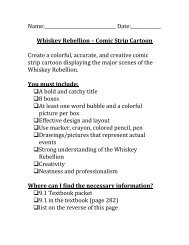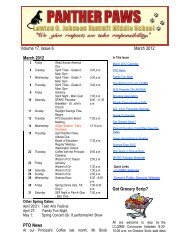Newton's Laws Review - Fc.summit.k12.nj.us
Newton's Laws Review - Fc.summit.k12.nj.us
Newton's Laws Review - Fc.summit.k12.nj.us
Create successful ePaper yourself
Turn your PDF publications into a flip-book with our unique Google optimized e-Paper software.
Newton’s <strong>Laws</strong> <strong>Review</strong>1. What is the ca<strong>us</strong>e of acceleration or a change in an object’s motion?2. For the balloon shown to the right, what is thegravitational force acting on the balloon?3. A gravitation force acts between the balloon andearth. What is the name for the type of force thatcan act at a distance?4. What is term <strong>us</strong>ed to describe the tendency of anobject to maintain its state of motion?5. Find the net force of a car with a weight of 2000 Nbeing accelerated across a table at 0.5 m/s 2 .(g=10 m/s 2 )6. According to Newton’s Second Law, when the sameforce is applied to two objects of different masses,what will be true about the acceleration of those masses?7. You throw a ball up into the air. While in the air, identify an action-reactionpair of forces.8. Newton stated that for every action there is an equal but opposite reaction.Which law is this?9. Newton stated that objects tend to remain in their state of motion unlessacted upon by an unbalanced force. Which law is this?10. What is the magnitude of the force of gravity acting on an object called?11. What is the amount of matter contained in an object called?12. You travel to the moon where g=1.6 m/s 2 with your favorite toy. Has theweight of your toy changed? Has the mass of your toy changed? Has thevolume of your toy changed?13. You have two black boxes on the moon, one labeled A and the other labeledB. After shaking them back and forth, you find A more difficult to shake backand forth. What can you conclude about the mass of A vs. the mass of B?What can you conclude about the weight of A vs. the weight of B?14. You have stacked up 4 books, each weighing 5 N. What is the normal forceacting on the second book from the bottom? If the coefficient of friction is0.2, what horizontal force do you need to p<strong>us</strong>h with to slide this book off ofthe one on the bottom?15. What is the weight of a 10 kg rocka. on earth? (g=10 m/s 2 )b. on the moon? (g=1.6 m/s 2 )16. Find the mass of a 750 N person on earth (g=10 m/s 2 )17. Find the weight of a 300 gram mass on earth (g=10 m/s 2 )18. You are driving a 2,000 kg car at a constant speed of 20 m/s. The forcesupplied by the engine is 2,500 N. Finda. the net force on the carb. the acceleration of the carc. the weight of the car (g=10 m/s 2 )d. the force of friction on the care. the coefficient of friction for the car on the road
NEWTON’S LAWS REVIEW ANSWERS1. Unbalanced force (also known as net force)2. 4050 N3. Field force4. Inertia5. The mass of the car is 200 kg. The acceleration is 0.5 m/s. So thenet force is (200 kg)(0.5 m/s 2 ) = 100 N6. The acceleration of the less massive object will be greater than themore massive object.7. Earth pulls down on ball (or gravity pulls down on ball) and ball pullsup on earth.8. Third law9. First law – the law of inertia10. Weight11. Mass12. The weight of the object will change. The mass and volume willremain unchanged.13. You conclude the mass of A is larger than the mass of B. However,since you have A and B at the same location (with g being thesame), the weight of A will also be larger than the weight of B.14. Draw the FBD of the 2 nd book from the bottom. There are threebooks on top of the book on the table p<strong>us</strong>hing down with 15 N. Thebook on the table will p<strong>us</strong>h up with 15 N of normal force. The forceof friction equals the coefficient of friction times the normal force.(0.2)(15 N) = 3N. You need to p<strong>us</strong>h with 3N of force.15. On earth (10 kg)(10 m/s 2 )=100 N and on the moon (10 kg)(1.6m/s 2 )= 1.6 N16. Weight = mass x g so mass=weight/g=750/10=7.5 kg17. 300 grams = 0.3 kg weight = (0.3 kg)(10 m/s 2 )=3 N18. Constant speed (in a straight line) means net force is zero. If thenet force is zero, the acceleration is also zero. The weight of the caris (2,000 kg)(10 m/s 2 )=20,000 N. The normal force will also be20,000 N. Since the net force is zero, we know that the frictionalforce is 2,500 N. µ=2,500/20,000=0.125


